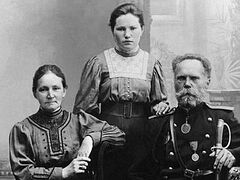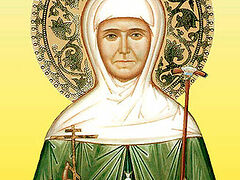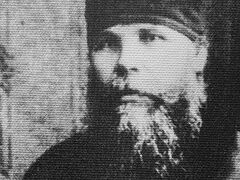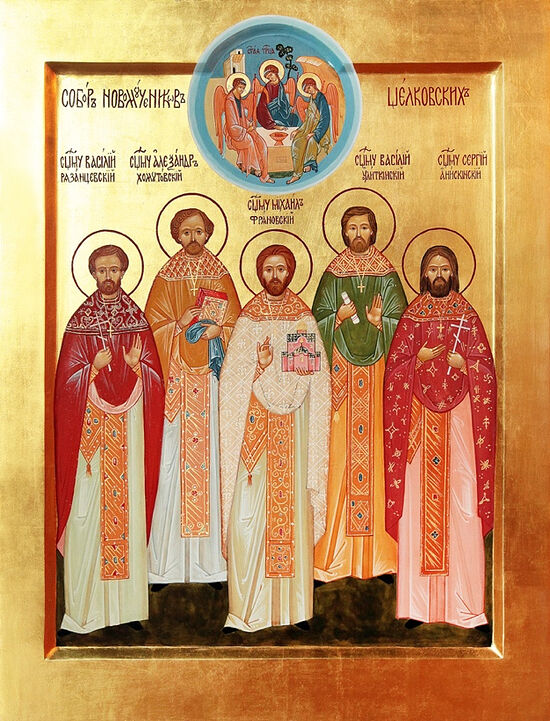 The Synaxis of the New Martyrs of Shchelkovo
The Synaxis of the New Martyrs of Shchelkovo
“The blood of martyrs is the seed of Christianity.” This phrase, which has already become an aphorism, belongs to Tertullian—a great Christian teacher of the second century. Its prophetic genius lies in the fact that, spoken at the dawn of Christian history, it is confirmed by the experience of subsequent Church history regardless of century or country. Whenever Christian blood was spilled, it became a fruitful seed, from which abundant fruits grew in the future. The more Christians were persecuted, the more numerous they became. The persecuted Church did not disappear, as persecutors had planned, but was transformed into a flourishing Church. So it was in Byzantium. The Roman Empire persecuted Christianity, but the Byzantine Empire—the Roman Empire’s successor—exalted it. So it was in Russia. Russia experienced this in the twentieth century. Then our entire Russian land became red—the color of the martyrs’ blood. And then it seemed that the end of Christianity in Russia was near. Now, however, as we look back from the twenty-first century to the twentieth century, we see that Tertullian was right, and for our country those trials became a time of spiritual “sowing”, which was done by Christian martyrs. They did not sow vegetable seeds into the ground, but watered it with their blood so that the Christian faith would multiply in their native Russia. And today we see that their sacrificial labor has been fully justified, because never before in Russia has the Church lived in such a privileged position as today, never before has it had such a period of prosperity.
The Shchelkovo land near Moscow was also involved then in the great labor of our ancestors and participated in the general “sowing”, giving the Church the New Martyrs of Shchelkovo, who are jointly celebrated on Thursday of the first week of the Apostles’ Fast. They suffered in the 1930s during the second wave of Stalin’s repressions. Mass repressions of the clergy began in the late 1920s, when the decree “On Measures to Strengthen Anti-Religious Work” was issued and handed over to the authorities of all cities and villages of the country. It read that “religious organizations... are the only legal active counter-revolutionary organization that has influence on the masses.” It was at the beginning of 1929. From that time on clergy were exiled in great numbers. Between 1929 and 1933 around 40,000 clergymen and minor orders were arrested in Russia, and many of them were executed by a firing squad. After that the persecution subsided a little, but early in 1937 a census of the USSR population was conducted, in which, by order of Stalin, the question of religious affiliation (from the age of sixteen) was included. And of 98.4 million people 55.3 million called themselves believers! The census showed that, despite massive repressions against the clergy, the faith had not been eradicated. This sad information for the authorities became one of the reasons why the results of that census were never made public, and the census was recognized as unsuccessful. But after it, the second amd bloodiest wave of persecution of Christians in the history of mankind began. The most terrible period in terms of the number of victims was 1937–1938. According to the Commission for the Rehabilitation of Victims of Political Repressions, over those two years around 165,000 clergymen and minor orders were arrested, of whom around 107,000 were shot.
The New Martyrs of Shchelkovo suffered during the second wave. All of them were so–called “kaers” (counter-revolutionaries)—those against whom charges of “counter-revolutionary activity” were fabricated. At that time such charges were not intended to protect the law, but were simply used to cleanse society of the “elements” the authorities wanted to get rid of. And such “elements” were the clergy.
Holy New Martyr Vasily Sungurov
 Holy New Martyr Vasily Sungurov in jail
Holy New Martyr Vasily Sungurov in jail
Priest Vasily Sungurov was the first of the New Martyrs of Shchelkovo to suffer. The future Fr. Vasily was born on March 20, 1876 in the village of Spasskoye of the Ruza district of Moscow province to the family of Reader Arseny Sungurov. After graduating from the Volokolamsk Theological School, in 1898 Vasily was appointed reader at St. Nicholas Church in the village of Amelfino in the Volokolamsk district.
In 1919, he was ordained a priest and assigned to the Church of St. Mary Magdalene in the village of Ulitkino of the Bogorodsky district (today Shchelkovo). For many years, until the church was closed in 1934, he served as its rector. Despite the fact that Fr. Vasily’s ministry was performed in an environment of increasing persecution, he remained faithful to his pastoral duty to the end.
It is known that once malefactors set fire to Fr. Vasily’s house when he was celebrating the Liturgy. But on learning about it, the priest did not stop the service, leaving that to the will of God. Another time during a cross procession a shed near the church caught fire. The participants of the cross procession were accused of arson.
In 1935, the “assembly of believers”, fabricated by the authorities, decided that the “Atheist” state farm needed a club, after which the church was closed. Before his imminent arrest, Fr. Vasily served at the Church of the Theophany in the village of Brykovo of the Istra district.
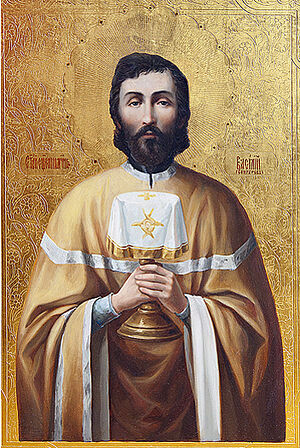 Holy New Martyr Vasily Sungurov Fr. Vasily was arrested on August 28, 1937 and sent to the Tagansky Prison in Moscow. Two witnesses on duty testified against the priest, and Fr. Vasily was then interrogated. After listening to the false evidence, the priest did not confirm it. On finishing the interrogation, the investigator asked him again:
Holy New Martyr Vasily Sungurov Fr. Vasily was arrested on August 28, 1937 and sent to the Tagansky Prison in Moscow. Two witnesses on duty testified against the priest, and Fr. Vasily was then interrogated. After listening to the false evidence, the priest did not confirm it. On finishing the interrogation, the investigator asked him again:
“Do you plead guilty to having been involved in counter-revolutionary activity until recently?”
“No, I don’t,” the priest replied.
On September 19, 1937, the NKVD troika sentenced Fr. Vasily to execution by a firing squad. Priest Vasily Sungurov was shot the next day, September 20, 1937, and buried in a mass grave at the Butovo firing range near Moscow.
On April 20, 2005, at the Bishops’ Council of the Russian Orthodox Church Priest Vasily was canonized and included among the holy New Martyrs and Confessors of Russia.
Holy New Martyr Sergei Kudryavtsev
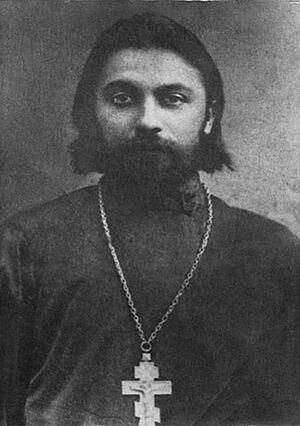 Holy New Martyr Sergei Kudryavtsev By the decree of the Holy Synod of the Russian Orthodox Church of August 21, 2007, Archpriest Sergei Kudryavtsev, who had served for many years at the Church of the Nativity of the Theotokos in the village of Aniskino, was also canonized as a new martyr.
Holy New Martyr Sergei Kudryavtsev By the decree of the Holy Synod of the Russian Orthodox Church of August 21, 2007, Archpriest Sergei Kudryavtsev, who had served for many years at the Church of the Nativity of the Theotokos in the village of Aniskino, was also canonized as a new martyr.
The future Hieromartyr Sergei Dmitrievich Kudryavtsev was born on July 1, 1881 in the village of Fryanovo, the Bogorodsky District of the Moscow Province (now Shchelkovo). He was the second child of the reader of the Church of St. John the Baptist in Fryanovo, Dmitry Fyodorovich Kudryavtsev. The Kudryavtsev family had three children besides Sergei: sons Nikolai (also a future hieromartyr) and Alexei, and a daughter, Maria, who later married Mikhail Mikhailovich Nikologorsky (who graduated from the Pererva Theological School)—the future priest-martyr of Fryanovo, about whom we will speak below.
After studying at the Moscow Theological Seminary, which he didn’t complete, in 1908 Sergei was ordained deacon and assigned to the Church of the Nativity of the Theotokos in the village of Aniskino, Bogorodsky district. When the question of Deacon Sergei’s priestly ordination was raised in 1911, a member of the Moscow Church Consistory, Archpriest Sergei Modestov, wrote in his reference letter: “Of very good behavior.” Deacon Sergei himself, in his “most respectful memo” addressed to the future martyred Metropolitan Vladimir (Bogoyavlensky) with humility: “There will certainly be candidates more worthy than me—those who have completed the full course of seminary.” And he even tried to refuse a petition to be second priest in the village of Aniskino.
On June 19, 1911, Deacon Sergei was ordained priest and appointed the second priest at the same church of the village of Aniskino, in which he had served as a deacon. His brother Nikolai was ordained deacon in his place. With the outbreak of the war between Russia and Germany in July 1914, Fr. Sergei was sent to the front, apparently as a chaplain. Fr. Sergei would not return to serve in his native church until 1930.
In August-September 1937, Fr. Sergei together with his son Nikolai moved to the place of his last ministry—as the rector of the Church of the Exaltation of the Cross in the town of Khvalynsk in the Saratov region, where he was destined to serve very little. On November 27, 1937, Archpriest Sergei Kudryavtsev was arrested by the Khvalynsk district department of the Directorate of the People’s Commissariat for the Internal Affairs (UNKVD) and escorted to the Volsk prison. During the search, his passport, two service records, fifteen crosses, ten “different prayer-books”, priestly vestments and pre-revolutionary identity card “with the stamp of Tsar Nicholas II” were seized.
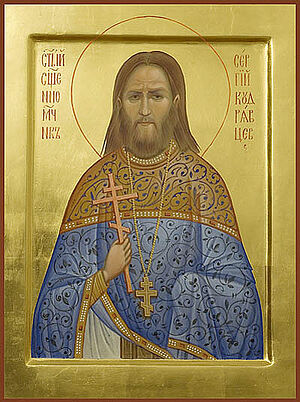 Holy New Martyr Sergei Kudryavtsev The next day, the new martyr was interrogated.
Holy New Martyr Sergei Kudryavtsev The next day, the new martyr was interrogated.
An extract from the minutes of the meeting of the judicial troika at the NKVD Directorate for the Saratov region dated December 10, 1937:
“You are a member of a counter-revolutionary group of church people, aren’t you?”
“I don’t know anything about a counter-revolutionary group of church people and I am not a member of it.”
“During the investigation you concealed your anti-Soviet agitation. Are you going to give truthful evidence?”
“I told you the truth, I can’t give any other evidence.”
It was decided to execute Kudryavtsev Sergei Dmitrievich by a firing squad.
The sentence was carried out on December 15, 1937 in the town of Volsk, the Saratov region. In 1956, by the intercession of the Prosecutor General of the Saratov region, the case was reviewed and Archpriest Sergei Kudryavtsev, along with other “members of the counterrevolutionary organization of church people were rehabilitated for lack of proof of the allegation.”
Hieromartyr Mikhail Nikologorsky
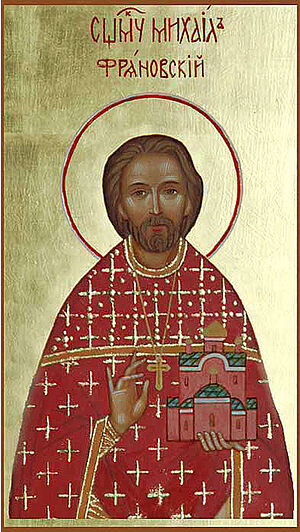 Hieromartyr Mikhail Nikologorsky The holy New Martyr Mikhail was born in 1883 in the village of Grebnevo, the Shchelkovo subdistrict of the Bogorodsky district, Moscow province, to the family of Reader Mikhail Nikologorsky, who served at St. Nicholas Church in Grebnevo. After graduating from the theological school in 1902, Mikhail Mikhailovich began to serve as a reader at the Church of St. John the Baptist in the village of Fryanovo, Aksenovo subdistrict of the Bogorodsky district, where from 1921 he was priest and rector until his arrest in 1937.
Hieromartyr Mikhail Nikologorsky The holy New Martyr Mikhail was born in 1883 in the village of Grebnevo, the Shchelkovo subdistrict of the Bogorodsky district, Moscow province, to the family of Reader Mikhail Nikologorsky, who served at St. Nicholas Church in Grebnevo. After graduating from the theological school in 1902, Mikhail Mikhailovich began to serve as a reader at the Church of St. John the Baptist in the village of Fryanovo, Aksenovo subdistrict of the Bogorodsky district, where from 1921 he was priest and rector until his arrest in 1937.
Early in 1937, an operative of the Shchelkovo department of the NKVD initiated an interrogation of witnesses who could testify about Priest Mikhail Nikologorsky.
“A resident of the village of Fryanovo testified that Father Mikhail, in a conversation about life under the Soviet regime allegedly said that at first he was afraid that there would be few Orthodox people under the Soviet regime and people would not go to church. But on the contrary, it turned out that the Orthodox go to church. Not everyone is crazy yet. And soon everyone will come to their senses, because the Soviet regime is a temporary phenomenon. It’s like a campfire: when dry it burns, and as it gets wet it goes out. The witness also testified that when in 1931–1932 the authorities wanted to close the church, the priest allegedly arranged meetings of believers at the church and organized groups of the faithful who would go to different villages collecting signatures so that the church would stay open.”1
The ex-deacon of the Church of St. John the Baptist, Mikhail Tikhomirov, who had abandoned his ministry, also testified against Fr. Mikhail. Having mentioned that he knew Priest Mikhail well, since he used to serve at the Fryanovo church as a reader and he himself as a deacon, the ex-deacon testified that in 1918 he abandoned his ministry, and Nikologorsky continued to serve.
“Nikologorsky’s political views are anti-Soviet, since he systematically expresses his dissatisfaction with the Soviet regime... more than once I had to prove to him that he was wrong, but Nikologorsky maintained his own opinion.”2
Fr. Mikhail was arrested on December 5, 1937 and immediately interrogated.
Excerpts from the interrogation:
“The investigation has information that you conducted anti-Soviet activity. Do you confirm this?”
“No, I don’t confirm it. I have not conducted any anti-Soviet activity.”
“You are lying to the investigation. The investigation invites you to tell us about your anti-Soviet activity.”
“I have not conducted any anti-Soviet activity.”
“The investigation has information that in September 1937 you had a counter-revolutionary conversation about life under the Soviet Government. Do you confirm this?”
“No, I don’t confirm it.”
Then the interrogations and the investigation were over, and Fr. Mikhail was transported to the Tagansky prison in Moscow. On December 7, 1937, the NKVD troika sentenced Fr. Mikhail to ten years in the labor camp on the White Sea-Baltic Canal, where he lived for a very short time. He died in confinement on March 2, 1938, and was buried in an unknown grave.
For many decades his spiritual children kept the testament of their spiritual mentor, uttered by him shortly before his arrest: “Pray more. The most important thing is to remember God.”

